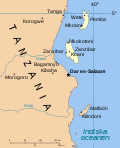 The Tanzania Portal
Tanzania, officially the United Republic of Tanzania, is a country in East Africa within the African Great Lakes region. It is bordered by Uganda to the northwest; Kenya to the northeast; the Indian Ocean to the east; Mozambique and Malawi to the south; Zambia to the southwest; and Rwanda, Burundi, and the Democratic Republic of the Congo to the west. According to the 2022 national census, Tanzania has a population of around 62 million, making it the most populous country located entirely south of the equator. Many important hominid fossils have been found in Tanzania. In the Stone and Bronze Age, prehistoric migrations into Tanzania included Southern Cushitic speakers similar to modern day Iraqw people who moved south from present-day Ethiopia; Eastern Cushitic people who moved into Tanzania from north of Lake Turkana about 2,000 and 4,000 years ago; and the Southern Nilotes, including the Datoog, who originated from the present-day South Sudan–Ethiopia border region between 2,900 and 2,400 years ago. These movements took place at about the same time as the settlement of the Mashariki Bantu from West Africa in the Lake Victoria and Lake Tanganyika areas. In the late 19th century, the mainland came under German rule as German East Africa, and this was followed by British rule after World War I when it was governed as Tanganyika, with the Zanzibar Archipelago remaining a separate colonial jurisdiction. Following their respective independence in 1961 and 1963, the two entities merged in 1964 to form the United Republic of Tanzania. Tanganyika joined the British Commonwealth and Tanzania remains a member of the Commonwealth as a unified republic. Tanzania is mountainous and densely forested in the north-east, where Mount Kilimanjaro, the highest mountain in Africa and the highest single free-standing mountain above sea level in the world, is located. Three of the African Great Lakes are partly within Tanzania. To the north and west lie Lake Victoria, Africa's largest lake, and Lake Tanganyika, the continent's deepest lake, known for its unique species of fish. To the south lies Lake Malawi. The eastern shore is hot and humid, with the Zanzibar Archipelago just offshore. The Menai Bay Conservation Area is Zanzibar's largest marine protected area. The Kalambo Falls, located on the Kalambo River at the Zambian border, is the second-highest uninterrupted waterfall in Africa. Tanzania is one of the most visited tourist destinations for safaris. Selected article - Tippu Tip, or Tippu Tib (c. 1837 – June 14, 1905), real name Ḥamad ibn Muḥammad ibn Jumʿah ibn Rajab ibn Muḥammad ibn Saʿīd al Murjabī (Arabic: حمد بن محمد بن جمعة بن رجب بن محمد بن سعيد المرجبي), was an Afro-Omani ivory and slave owner and trader, explorer, governor and plantation owner. He worked for a succession of sultans of Zanzibar and was the Sultan of Uterera, a short-lived state in Kasongo, Maniema ruled by himself and his son Sefu. Tippu Tip traded in slaves for Zanzibar's clove plantations. As part of the large and lucrative trade, he led many trading expeditions into Central Africa, constructing profitable trading posts deep into the Congo Basin region and thus becoming the best-known slave and ivory trader in Africa, supplying much of the world with ivory from enslaved Africans. (Full article...) General images -The following are images from various Tanzania-related articles on Wikipedia.
This month in Tanzanian history
Wildlife of Tanzania - Credit: Trisha Shears
The western or lowland bongo, Tragelaphus eurycerus eurycerus, is a herbivorous, mostly nocturnal forest ungulate and among the largest of the African forest antelope species. Bongos have a reddish-brown coat, black and white markings, white-yellow stripes and long slightly spiralled horns. Indeed, bongos are the only Tragelaphid in which both sexes have horns. Bongos have a complex social interaction and are found in African dense forest mosaics. Did you know ...
CategoriesWikiProjectsRecognised contentSelected panorama -Morogoro is a city with an urban population of 206,868 (2002 census) in the southern highlands of Tanzania, 190 km west of Dar es Salaam. It is the capital of the Morogoro Region. It is also known informally as "Mji kasoro bahari," which translates as 'city short of an ocean/port'.
Uganda–Tanzania War -Articles here focus upon aspects of the Uganda–Tanzania War. These are all Good articles that meet a core set of high editorial standards.
The Battle of Mutukula (Kiswahili: Mapigano ya Mutukula) took place from 21 to 22 January 1979 near and in the town of Mutukula, Uganda, during the Uganda–Tanzania War. After repulsing a Ugandan invasion of the Kagera Salient in 1978, Tanzanian commanders feared that Ugandan forces stationed upon the high ground in Mutukula, a town located along the Tanzania–Uganda border, still posed a threat to their territory. On the night of 21 January 1979 the Tanzanian 208th Brigade crossed the border and surrounded the town. The following morning it attacked, and the Ugandan garrison—including the Gondo and Suicide Battalions—fled. Afterwards the Tanzanians razed the locale in revenge for the damage wrought by the Ugandans in Kagera. (Full article...) TopicsSelected picture - Credit: Muhammad Mahdi Karim
Mount Kilimanjaro, an inactive stratovolcano in north-eastern Tanzania. At 5,895 metres (19,341 feet), Kilimanjaro is Africa's highest mountain and the tallest freestanding mountain in the world. It has three volcanic cones—Kibo, Mawenzi, and Shira. ...Archive — Nominations
Related portalsThings you can doAssociated WikimediaThe following Wikimedia Foundation sister projects provide more on this subject:
Discover Wikipedia using portals | ||||





































































